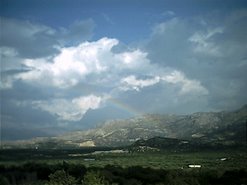Γιαπωνέζικο θέατρο Νο, Kokaji (The swordsmith) and Kuzu. Βρίσκεται ολόκληρο στο youtube
Summaries
Summaries
KOKAJI:
An envoy of 11th century emperor Ichijo informs the swordsmith Kokaji Munechika that the emperor requests him to make a sword in accordance with a dream he has had. As Munechika has no assistant with the proper skills, he goes to the Inari Shrine to pray. There, a boy comes to him and, urging Munechika to fulfill the request tells him that he will provide all the help he will need. Munechika returns to his home and prepares for the ceremonial forging of the sword. With his prayers, the deity Inari appears in its form as a fox and helps Munechika to complete the emperor’s request and present the sword to the envoy.
At the command of Emperor Ichijo (980-1011), who received an oracle in a dream, Tachibana no Michinari visits and orders Sanjō no Kokaji Munechika, a renowned swordsmith, to forge a sword. Munechika insists that he cannot forge the sword because he does not have a partner swordsmith, who is as skilful as Munechika is. Michinari however refuses to accept his request. Munechika, who is caught between a rock and a hard place, visits Inari Shrine where he prays and requests the assistance of the guardian deity of his clan. At the shrine, a mysterious boy calls to him. The boy encourages Munechika by talking about the dignity of a sword in a Chinese legend and the story of Yamato Takeru-no-mikoto. He promises to become Munechika’s smithing partner and disappears in Mount Inari.

“Kokaji” is a popular piece whose story develops quickly, is quite variegated, and includes climaxes in both halves of the drama. The scene where the mysterious boy, who appears in the first half, talks about the spiritual power of great swords, particularly the episode in which Yamato Takeru-no-mikoto who is surrounded by fire slashes grass with his sword Kusanagi to return flames around him and stood down enemies, includes amusing changes of narration and movements. In the latter half, the scenes where the deity becomes the forging partner and Munechika and the deity forge a sword to the climax produce the charms of the piece.
An envoy of 11th century emperor Ichijo informs the swordsmith Kokaji Munechika that the emperor requests him to make a sword in accordance with a dream he has had. As Munechika has no assistant with the proper skills, he goes to the Inari Shrine to pray. There, a boy comes to him and, urging Munechika to fulfill the request tells him that he will provide all the help he will need. Munechika returns to his home and prepares for the ceremonial forging of the sword. With his prayers, the deity Inari appears in its form as a fox and helps Munechika to complete the emperor’s request and present the sword to the envoy.
At the command of Emperor Ichijo (980-1011), who received an oracle in a dream, Tachibana no Michinari visits and orders Sanjō no Kokaji Munechika, a renowned swordsmith, to forge a sword. Munechika insists that he cannot forge the sword because he does not have a partner swordsmith, who is as skilful as Munechika is. Michinari however refuses to accept his request. Munechika, who is caught between a rock and a hard place, visits Inari Shrine where he prays and requests the assistance of the guardian deity of his clan. At the shrine, a mysterious boy calls to him. The boy encourages Munechika by talking about the dignity of a sword in a Chinese legend and the story of Yamato Takeru-no-mikoto. He promises to become Munechika’s smithing partner and disappears in Mount Inari.
When Munechika goes home, dresses himself for
smithing and prays on his platform, there appears before him the deity
of Inari who transforms into the spirit of a fox. The deity announces
that he will work as the partner of Munechika. The boy who appeared a
moment earlier was the transformed Inari deity himself. Munechika, who
gained the deity as the smithing partner, successfully forges a sword.
Finally, the noted sword ‘Kogitsune-maru’ which is engraved with two names – “Kokaji Munechika” on the face and “Kogitsune
(Little Fox)” on the back of the blade as a proof that the deity
apprenticed himself to Munechika – is completed. After offering the
sword to the imperial messenger, the deity rides on a cloud to return to
the peak of Mount Inari.
“Kokaji” is a popular piece whose story develops quickly, is quite variegated, and includes climaxes in both halves of the drama. The scene where the mysterious boy, who appears in the first half, talks about the spiritual power of great swords, particularly the episode in which Yamato Takeru-no-mikoto who is surrounded by fire slashes grass with his sword Kusanagi to return flames around him and stood down enemies, includes amusing changes of narration and movements. In the latter half, the scenes where the deity becomes the forging partner and Munechika and the deity forge a sword to the climax produce the charms of the piece.
The sharp movements and invigorating chants never
allow the audience to become bored. You can straightforwardly enjoy the
performers’ smart skills and the power of chorus. Probably due to its
highly entertaining nature, the story is transformed into dramas for
kabuki and bunraku (Japanese traditional puppet theater) and provides pleasure to a wider variety of audiences.
KUZU:
The play, set in 7C AD, depicts a scene of the fight for the emperor's throne between Ooama-no-ouji (the name given to Tenmu-tenno before winning the battle and becoming the 40th emperor of Japan) and his cousin - Ootomo-no-ouji (Kobun-tenno, 39th emperor of Japan). Prince Ooama has fled the palace and is being pursued by Ootomo-no-ouji. Ooama has found refuge in the mountainous region of Kuzu, located in Yoshino. There he meets an old man, who is actually the incarnation of Zao-gongen (the main deity, worshipped in Shugendo). With the old man's help, Ooama is able to escape his pursuers. Finally a celestial maiden appears and dances for the benefit of the prince. Zao-gongen also appears and blesses the land and its people with peace and harmony.
The play, set in 7C AD, depicts a scene of the fight for the emperor's throne between Ooama-no-ouji (the name given to Tenmu-tenno before winning the battle and becoming the 40th emperor of Japan) and his cousin - Ootomo-no-ouji (Kobun-tenno, 39th emperor of Japan). Prince Ooama has fled the palace and is being pursued by Ootomo-no-ouji. Ooama has found refuge in the mountainous region of Kuzu, located in Yoshino. There he meets an old man, who is actually the incarnation of Zao-gongen (the main deity, worshipped in Shugendo). With the old man's help, Ooama is able to escape his pursuers. Finally a celestial maiden appears and dances for the benefit of the prince. Zao-gongen also appears and blesses the land and its people with peace and harmony.








No comments:
Post a Comment